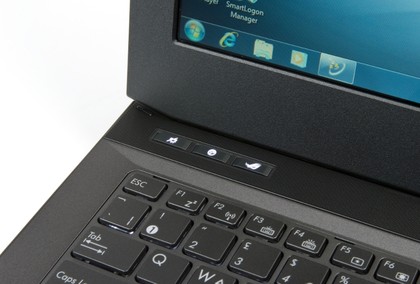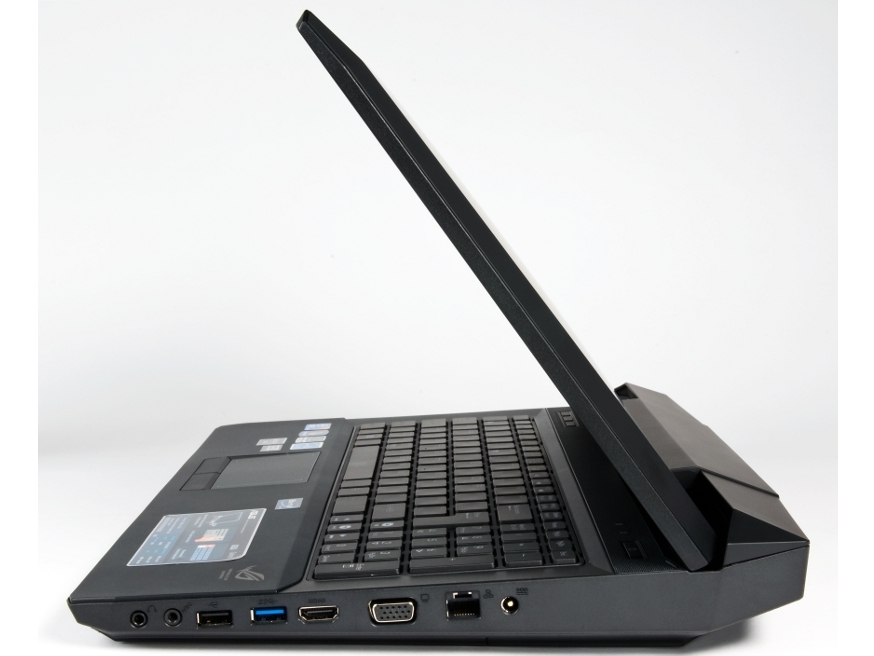Why you can trust TechRadar
Obviously it is the 3D abilities of the Asus G53Jw that is the key selling point and, while Asus' previous 3D machine, the G51J utilised Nvidia's 3D Vision technology via an external USB 3D receiver, the Asus G53Jw has built the receiver into the chassis for easier and tidier usability.
Activated and deactivated by a hotkey above the keyboard, the 3D Vision technology synchronises easily with the supplied 3D glasses for an immersive experience when viewing photos or videos and playing games.
As with all Nvidia 3D Vision and ATI HD3D-based machines, the 3D effect is created through the use of active shutter glasses. This works by opening and closing the lens covering each eye in turn, in time with the refresh rate of the Asus G53Jw's screen.
In this way, the screen shows each eye a different image faster than the naked eye can register and tricks your brain into seeing a three-dimensional image that does not exist. The result is extremely effective, with images leaping from the screen with an impressive illusion of depth.

The technology works particularly well when playing games and Nvidia has worked closely with a wide range of games developers to ensure a comprehensive array of high-quality titles can be played in full 3D.
This includes such market-leading games as Call of Duty: Modern Warfare 2 and Batman: Arkham Asylum, among others, and the extra depth that 3D Vision adds to these games makes them among the most immersive entertainment experiences we've seen to date.
Unfortunately, however, the most common flaw of Nvidia's 3D Vision technology remains as present as ever when using the 3D features of the Asus G53Jw. Whenever we've tested previous 3D Vision-equipped machines such as the Toshiba Satellite A665-11Z and the Asus G51J, the active shutter glasses have the unfortunate downside of greatly reducing the brightness and impact of the laptop's screen when viewing 3D content.
The same flaw is on display here, with images greatly lacking vibrancy when viewed through the 3D glasses. While we had always previously assumed this flaw was inherent to active shutter technology, the rival ATI HD3D technology seen on the HP Envy 17 3D uses active shutter glasses to far greater effect, without impacting on screen brightness, so it seems totally avoidable and unnecessary for this flaw to still be present on the Asus G53Jw.
Nvidia has been aware of this situation for some time, however, and claims to be working to rectify the situation for future iterations.
More disappointingly, the Asus G53Jw's 15.6-inch screen is not without its own inherent flaws. While the screen is suitably bright and vivid and its 1366 x 768-pixel resolution allows you to watch high-definition 720p videos in all their glory, the screen itself has one of the worst viewing angles we've seen on any laptop this year.
Unless you view the screen straight on, with not even a degree of change in your angle, there are notable dark areas on all but the centre of the panel, leading to a consistently washed out and flawed image.
While it could be argued that it is essential to view any 3D screen straight-on in order to get the most accurate 3D effect, that is no excuse to provide such a limited viewing angle, as most rival 3D laptops provide far better performance in this area.

Since most users will be working without wearing the 3D glasses for the majority of the time, this screen flaw makes the Asus G53Jw a little hard to recommend for long-term use, for work or play.
Thankfully the balance is redressed somewhat by the excellent performance provided by the Asus G53Jw's cutting-edge components.
The quad-core Intel Core i7 processor powers the most resource-consuming software with ease and ensures that light work is made of even complex multitasking. The 8GB of memory adds to this performance, as applications open and respond quickly and even the largest files can be quickly loaded into your software of choice.
Graphics are just as capable, with Nvdia's DirectX 11-compatible GeForce GTX 460M graphics card running the latest games with aplomb.
While you shouldn't expect quite the same level of power you'd find on such high-end rivals as the Alienware M17x, the Asus G53Jw is nevertheless a powerful and reliable gaming and multimedia machine, with more than enough power for running your home office, as well as gaming and editing and enjoying your photos and high-definition videos.
Current page: Asus G53Jw review: Performance
Prev Page Asus G53Jw review: Specification Next Page Asus G53Jw review: Verdict